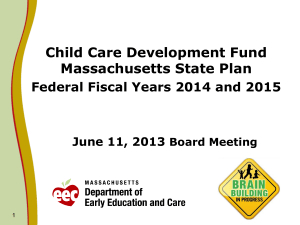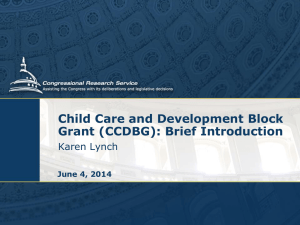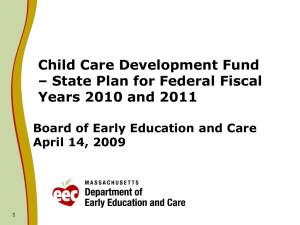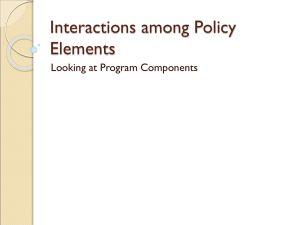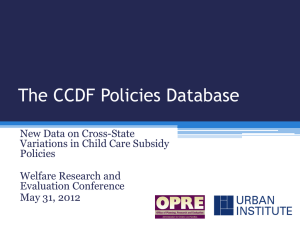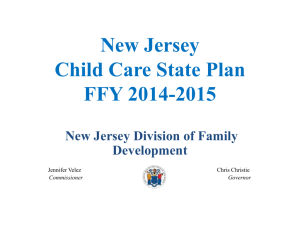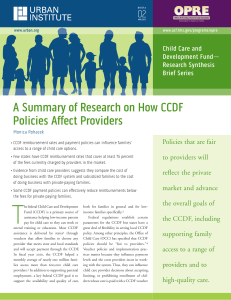Child Care Assistance for Parents in Education and Training Executive Summary
advertisement
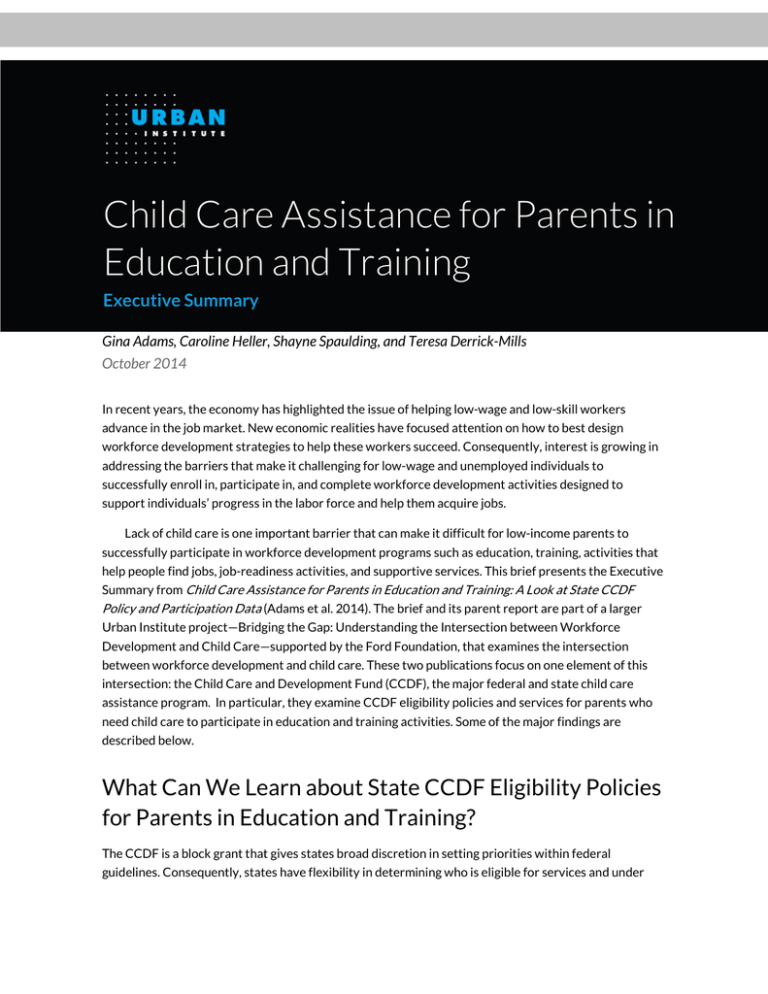
Child Care Assistance for Parents in Education and Training Executive Summary Gina Adams, Caroline Heller, Shayne Spaulding, and Teresa Derrick-Mills October 2014 In recent years, the economy has highlighted the issue of helping low-wage and low-skill workers advance in the job market. New economic realities have focused attention on how to best design workforce development strategies to help these workers succeed. Consequently, interest is growing in addressing the barriers that make it challenging for low-wage and unemployed individuals to successfully enroll in, participate in, and complete workforce development activities designed to support individuals’ progress in the labor force and help them acquire jobs. Lack of child care is one important barrier that can make it difficult for low-income parents to successfully participate in workforce development programs such as education, training, activities that help people find jobs, job-readiness activities, and supportive services. This brief presents the Executive Summary from Child Care Assistance for Parents in Education and Training: A Look at State CCDF Policy and Participation Data (Adams et al. 2014). The brief and its parent report are part of a larger Urban Institute project—Bridging the Gap: Understanding the Intersection between Workforce Development and Child Care—supported by the Ford Foundation, that examines the intersection between workforce development and child care. These two publications focus on one element of this intersection: the Child Care and Development Fund (CCDF), the major federal and state child care assistance program. In particular, they examine CCDF eligibility policies and services for parents who need child care to participate in education and training activities. Some of the major findings are described below. What Can We Learn about State CCDF Eligibility Policies for Parents in Education and Training? The CCDF is a block grant that gives states broad discretion in setting priorities within federal guidelines. Consequently, states have flexibility in determining who is eligible for services and under what circumstances. However, limited funding for the CCDF means that being eligible does not ensure that families can get assistance if they apply. To assess whether parents seeking child care assistance for workforce development activities are eligible for subsidies in different states, this analysis examines the CCDF Policies Database, which 1 compiles and publishes CCDF eligibility rules. Because teen parents and parents in the Temporary Assistance for Needy Families (TANF) program are more likely to be able to get subsidies for such activities, this analysis focuses specifically on the eligibility of nonteen parents and parents not in 2 TANF. 3 The assessment finds that almost every state (49 out of 50, and the District of Columbia) allows these parents to be eligible for child care assistance for at least one of the following education and training activities: postsecondary education and training, high school or General Educational Development (GED) certification, and English literacy programs. However, eligibility varies somewhat across these different activities: Forty-seven states and the District of Columbia allow parents seeking child care assistance for postsecondary education and training to be eligible for CCDF subsidies. Forty-six states and the District of Columbia allow parents seeking child care assistance for high school or GED programs to be eligible. Fewer states (29 and the District of Columbia) allow parents seeking assistance for English literacy courses to be eligible. Though the CCDF Policies Database does not include eligibility requirements for adult basic education, a review of policy manuals suggests that 22 of the 25 states that mention adult basic education identify it as an eligible activity for parents. It is not possible to ascertain the policies of the remaining states. However, the CCDF database shows that over half of states (27) have established one or more additional eligibility requirements for these activities, though states vary widely in their type (and number) of requirements. Most of these additional requirements can be categorized as requirements that limit whether parents can get child care for postsecondary degrees to particular types of degrees or to a limited number of degrees (17 states); limit child care eligibility to parents seeking education and training to support activities that are most likely to lead to immediate employment (11 states); require parents to also work while participating in education and training to be eligible for child care assistance (seven states); limit the length of time parents can get child care assistance for particular workforce development activities and/or establish requirements as to how much time they must spend on the activity to be eligible (seven states); 2 CHILD CARE ASSISTANCE FOR PARENTS IN EDUCATION AND TRAINING link child care eligibility to performance in workforce activities, such as grade requirements (four states); and limit subsidy eligibility to enrollment in workforce development activities that involve preapproved training vendors or institutions to assure quality (such as requiring use of an accredited program) (three states). Some states have more than one of these requirements operating simultaneously. For example, some establish both degree limits and vocational requirements for child care eligibility for parents in postsecondary education and training programs. A comparison of these additional requirements to what is known about (1) the realities facing lowincome parents in workforce activities, (2) current promising approaches in the workforce development field, and (3) existing research on factors that support success suggests that though some of these requirements reflect the current knowledge about successful education and training strategies, others may inadvertently limit access and completion: Some state restrictions seem, at least initially, to reflect the workforce development field’s concerns about maximizing the likelihood that education and training activities will support the parent’s trajectory toward gainful employment. These include programs at approved institutions and requirements that subsidies only are available to support enrollment in programs likely to lead to employment in a particular occupation. A deeper examination of these requirements is needed, but in general, this kind of restriction appears to align with current practices in the public workforce system. If developed in concert with best practices in the workforce domain, such restrictions could support more successful outcomes. Other restrictions may inadvertently limit low-income parents’ ability to succeed. In particular, policies limiting eligibility for workforce development activities to parents who also work, limiting eligibility to a particular period, or requiring that parents be in education and training a minimum number of hours, may create barriers for low-income parents to successfully attend and complete education and training programs. Specifically, we know the following: » In late 2008 and early 2009, almost half of low-income parents who participated in education and training programs also worked while trying to raise their children (Eyster, Callan, and Adams 2014). This means that parents are likely to take longer to complete the activity and may be challenged to meet minimum hour requirements. » Almost three out of five low-income parents face additional challenges of low education levels. In late 2008 and early 2009, the Survey of Income and Program Participation reported that 26 percent of low-income parents ages 18–50 had less than a high school diploma (Eyster, Callan, and Adams 2014), and another 32 percent had only a high school 4 diploma or GED. This means that they will likely need more time to achieve education and training goals, a reality that would be challenging with time limits for child care eligibility. » Research suggests that intensive, full-time programming may be most effective for families, but the realities facing families may limit their ability to participate at this level (Attewell, CHILD CARE ASSISTANCE FOR PARENTS IN EDUCATION AND TRAINING 3 Heil, and Reisel 2012; Crosta 2013; Tanaguchi and Kaufman 2005). Requirements that limit child care assistance to those who work can create additional challenges (Ben-Ishai 2014; Ben-Ishai, Matthews, and Levin-Epstein 2014; Horn and Berktold 1998; Watson, Frolich, and Johnston 2014). These facts suggest that to be effective, state child care eligibility policies should be designed to reflect these realities. Specifically, states might consider supporting parents’ ability to participate in education and training activities full time if they can afford to do so (for example, by not imposing work requirements for families in these activities). However, they may also want to ensure that parents who have to juggle their education and training efforts with work and parenting or parents who may have low basic skills can take the time needed to successfully complete education and training courses (for example, by not imposing time limits or minimum levels of participation). States could, for example, look at data on completion rates and times for parents in education programs to understand how long it takes a low-income working parent to complete college or to attain needed credentials. Finally, other restrictions that seem reasonable may create challenges for some parents with legitimate education and training needs. For example, blanket limitations on child care eligibility related to the number of degrees a parent can get may not recognize that in some cases multiple degrees may be necessary (such as a parent who graduated from college several years ago with a degree in English who now desires a vocational degree). Similarly, requiring that parents get a particular grade can be useful in ensuring that resources are not spent on parents who are failing; for parents who have been out of school for a long time, however, some initial failing grades may be simply a measure of the challenges of adjusting to being a student again. In both these areas, it would be useful to explore potential strategies that would accomplish the state’s reasonable goals without penalizing parents with legitimate needs. Are Parents Who Get Assistance from the CCDF Doing So to Support Education and Training Activities? A different way to look at the CCDF and education and training is to examine state data on the number 5 and characteristics of the families states serve with CCDF funds. An analysis of 2011 data provides the following picture of families receiving CCDF assistance (these numbers include teen parents and at least some parents receiving TANF): 6 In 2011, 957,947 families received child care assistance from the CCDF in a typical month. Of those, 904,454 received such assistance because they were working or in education and training, and 47,557 families received such assistance because the child was in the protective services system. (These totals include some families reporting TANF income.) The remaining data for 5,935 families were invalid or not reported. 4 CHILD CARE ASSISTANCE FOR PARENTS IN EDUCATION AND TRAINING Approximately one in five, or 19 percent, of the families receiving subsidies (including families reporting TANF income) received CCDF assistance because they were in some form of education or training program. About 11 percent were using it for education and training alone, and about 8 percent were using it for education and training coupled with work. About 18 percent of families getting CCDF assistance reported receiving income from TANF, which usually provides child care assistance to families who are required to participate in workrelated activities; about half of these TANF families were using their CCDF assistance for education and training. Of the families who did not report receiving TANF, about 12 percent of parents were getting child care assistance to support education and training activities. Almost 7 percent were getting assistance for education and training alone, and almost 5 percent were getting assistance for education and training coupled with work. (A few states did not have capacity to capture parents who were receiving assistance for more than one purpose, so the latter category may be underrepresented.) However, all these patterns varied significantly by state. For example, the proportion of all nonTANF families receiving child care assistance who were receiving it for any education and training purposes ranged from more than 25 percent of families in the District of Columbia, Idaho, and Tennessee to less than 5 percent in Arizona, Connecticut, Kansas, New York, Oregon, Rhode Island, Utah, and Wisconsin. Clearly, though most states allow parents in education and training to be eligible for subsidies, they vary enormously in whether and how they use their CCDF funds to serve these families. Conclusions and Next Steps These data provide a glimpse into the CCDF and how it is functioning for low-income parents needing child care to participate in education and training. Though they suggest that at least some education and training activities are an allowable eligibility category for child care assistance in most states, they also suggest that there is enormous variation in whether states actually provide child care assistance to families for education and training purposes. The data provide some initial insights into whether child care experts and state policymakers understand the constraints and opportunities for these families and whether state eligibility policies reflect current understanding of education and training strategies. They also provide an important foundation for additional exploration into the full range of policies and practices, from the perspectives of both child care and education and training initiatives, that create barriers or opportunities for families. The CCDF data also raise questions worth further examination. For example, though there often are smaller proportions using child care for education and training in states that clearly limit eligibility, the broad eligibility policies examined here do not seem to explain the variation in the proportion of state caseloads that get assistance for education and training purposes. Why? Do state variations CHILD CARE ASSISTANCE FOR PARENTS IN EDUCATION AND TRAINING 5 reflect differences in demand (i.e., differences in whether parents seek child care assistance for these activities)? Do they reflect differences in how states operate their subsidy programs (i.e., variation in whether parents in education and training are lower priority, or whether subsidy policies make it easier or harder to get and keep subsidies for education and training)? Do they reflect conscious choices about allocating scarce state resources, or is it an inadvertent effect of policies designed for other purposes? Do they reflect different relationships between the child care and workforce development systems? Several of these issues are likely at play in different combinations and in different ways across states. Early findings from the second phase of the Urban Institute’s Bridging the Gap project provide initial insights into some of these questions (Spaulding, Adams, and Heller, forthcoming). It appears that many other policies and practices—within both the CCDF and education and training programs—shape whether parents in education and training programs are referred to the CCDF and whether they can access and retain subsidies. Further exploration of these policies is under way to identify barriers and opportunities to facilitate participation for families needing child care for education and training. Therefore, though these data provide a glimpse into the CCDF and how it is currently functioning for low-income parents needing child care to participate in education and training, additional information is needed to design more-effective systems. Some useful areas of inquiry include the following: To effectively target CCDF subsidies, more information is needed about the nature of the child care barrier for parents needing workforce development activities to succeed, as well as whom it affects and its implications for parents and children. Consequently, more work needs to be done to understand the nature, size, and implications of this unmet need, as well as how it varies across different populations. This analysis should include the implications for parents’ ability to access and complete workforce development activities and the implications for parents’ ability to ensure that their children are able to get stable, quality care that supports their development. Broader CCDF policies and practices (beyond the eligibility rules examined in this brief and its parent report) are clearly supporting or hindering access to child care subsidies for families in workforce development programs. What are these policies, and are there promising strategies that can support parents’ abilities to obtain child care assistance for education and training activities? Though the CCDF is a primary source of child care funding, it is not the only child care and early education program that can help meet the child care and early education needs of parents seeking to benefit from education and training or other workforce development activities. There are, for example, innovative efforts to support two-generation models based on Head Start and other early childhood education programs. How can the CCDF work with other early childhood programs and workforce development initiatives to best meet the needs of parents seeking advancement and their children’s healthy development? 6 CHILD CARE ASSISTANCE FOR PARENTS IN EDUCATION AND TRAINING What information and supports do child care and workforce experts need to help bridge the gap between their systems and to establish effective partnerships? In conclusion, though more information is needed, these data suggest widely varying priorities, policy decisions, and implementation practices across states in this area. The information provided in this brief and its parent report is just the beginning of our exploration of these issues. Much more information is necessary to create a strong, coordinated strategy that bridges the worlds of education and training and child care to meet the needs of low-income parents and their children. Notes 1. For a description of state and territory policies under the CCDF, see Minton et al. (2013). 2. As much as possible, the analyses focus specifically on whether parents who are not teenagers and who are not on TANF would be eligible for child care subsidies under state eligibility policies. This focus is because teen parents and parents on TANF are often a higher priority for getting subsidies. This analysis does not provide insights into whether these policies are also applicable to teen parents and parents on TANF. 3. The total number of states for the CCDF analysis is 50 states and the District of Columbia. 4. Urban Institute tabulations of 2008 Survey of Income and Program Participation, which covers December 2008 to March 2009. 5. These data are taken from the administrative data states submit monthly to the Administration for Children and Families at the US Department of Health and Human Services. The data are unpublished and were supplied to Urban Institute researchers by the Office of Child Care. These data cover their child care subsidy expenditures, including how many children and families were supported, the ages of children, whether the families were also supported by TANF, reasons for care, and the type of child care supported. The Administration for Children and Families uses these data to compile information about program participation for an average month. These data are from the fiscal year 2011 CCDF case-level administrative data reported by states to the federal Office of Child Care on the ACF-801 form. The figures provided in this section have been calculated using the federal fiscal year 2011 ACF-801 data for an average month. They focus on (1) the total number of parents where the reported reason for receiving child care assistance was to support education and training (either alone, or coupled with work) and (2) data on characteristics such as whether families are receiving TANF, information about their children, and about the type of care they use. Note that state definitions of education and training may differ. 6. These totals include all parents served with CCDF funds and funds transferred from the TANF program to CCDF, including families receiving TANF income. These families are subject to CCDF rules and regulations. However, the totals do not include parents on TANF whose child care is paid for directly by TANF without being transferred. No data are available about the numbers of families in this latter group. References Adams, Gina, Caroline Heller, Shayne Spaulding, and Teresa Derrick-Mills. 2014. Child Care Assistance for Parents in Education and Training: A Look at State CCDF Policy and Participation Data. Washington, DC: Urban Institute. Attewell, Paul, Scott Heil, and Liza Reisel. 2012. “What Is Academic Momentum? And Does It Matter?” Educational Evaluation and Policy Analysis 34 (1): 27–44. Ben-Ishai, Liz. 2014. Job Schedules that Work for Students. Washington, DC: Center for Law and Social Policy. Ben-Ishai, Liz, Hannah Matthews, and Jodie Levin-Epstein. 2014. Scrambling for Stability: The Challenges of Job Schedule Volatility and Child Care. Washington, DC: Center for Law and Social Policy. CHILD CARE ASSISTANCE FOR PARENTS IN EDUCATION AND TRAINING 7 Crosta, Peter M. 2013. “Intensity and Attachment: How the Chaotic Enrollment Patterns of Community College Students Affect Educational Outcomes.” CCRC Working Paper 60. New York: Community College Research Center, Teachers College, Columbia University. Eyster, Lauren, Thomas Callan, and Gina Adams. 2014. Balancing School, Work, and Family: Low-Income Parents’ Participation in Education and Training. Washington, DC: Urban Institute. Horn, Laura J., and Jennifer Berktold. 1998. Profile of Undergraduates in US Postsecondary Education Institutions: 1995-96, With an Essay on Undergraduates Who Work. NCES 98-084. Washington, DC: US Department of Education, National Center for Education Statistics. Minton, Sarah, Christin Durham, Erika Huber, and Linda Giannarelli. 2013. “The CCDF Policies Database Book of Tables: Key Cross-State Variations in CCDF Policies as of October 1, 2012.” Washington, DC: Urban Institute. http://www.urban.org/publications/412977.html. Spaulding, Shayne, Gina Adams, and Caroline Heller. Forthcoming. Bridging the Gap: Understanding the Basics of the Intersections between Workforce Development and Child Care. Washington, DC: Urban Institute. Tanaguchi, Hiromi, and Gayle Kaufman. 2005. “Degree Completion among Nontraditional College Students.” Social Science Quarterly 86 (4): 912–27. Watson, Liz, Lauren Frohlich, and Elizabeth Johnston. 2014. Collateral Damage: Scheduling Challenges for Workers in Low-Wage Jobs and Their Consequences. Washington, DC: National Women’s Law Center. About the Authors Gina Adams, a senior fellow in the Center on Labor, Human Services, and Population at the Urban Institute, is a national expert on factors that shape the affordability, quality, and supply of child care/early education services, and the ability of low-income families to benefit from them. Caroline Heller is a research assistant in the Center on Labor, Human Services, and Population at the Urban Institute. Since joining Urban in 2013, she has contributed to research focused primarily on early childhood, including early childhood education, child care, and home visiting. Shayne Spaulding is a senior research associate in the Income and Benefits Policy Center at the Urban Institute, where her work focuses on the evaluation of workforce development and postsecondary education programs. Teresa Derrick-Mills is a senior research associate at the Urban Institute. She is the project director and co-principal investigator of the Evaluation of the Head Start Designation Renewal System and the Head Start Leadership, Excellence, and Data Systems projects. 8 CHILD CARE ASSISTANCE FOR PARENTS IN EDUCATION AND TRAINING Acknowledgments We would like to extend our sincerest gratitude to our project officers at the Ford Foundation for their support, including Chauncy Lennon who initially saw the importance of this area of work, and Helen Neuborne, Laine Romero-Alston, and Anna Wadia, who have continued to support our efforts. We also would like to thank Christin Durham, Lauren Eyster, Pamela Loprest and Sarah Minton of the Urban Institute; Shannon Rudisill, Joseph Gagnier, Helen Papadopoulos and Karen Aschaffenburg of the Office of Child Care at ACF; and Hannah Matthews of the Center for Law and Social Policy (CLASP) for their assistance, insights, and careful review. This brief is part of a larger Urban Institute project—Bridging the Gap: Understanding the Intersection between Workforce Development and Child Care—supported by the Ford Foundation, that examines the intersection between workforce development and child care. It is a joint product of two cross-center Urban Institute initiatives: the Kids in Context Initiative and the Postsecondary Education and Training Initiative. ABOUT THE URBAN INSTITUTE 2100 M Street NW Washington, DC 20037 www.urban.org The nonprofit Urban Institute is dedicated to elevating the debate on social and economic policy. For nearly five decades, Urban scholars have conducted research and offered evidence-based solutions that improve lives and strengthen communities across a rapidly urbanizing world. Their objective research helps expand opportunities for all, reduce hardship among the most vulnerable, and strengthen the effectiveness of the public sector. Copyright © October 2014. Urban Institute. Permission is granted for reproduction of this file, with attribution to the Urban Institute. CHILD CARE ASSISTANCE FOR PARENTS IN EDUCATION AND TRAINING 9
